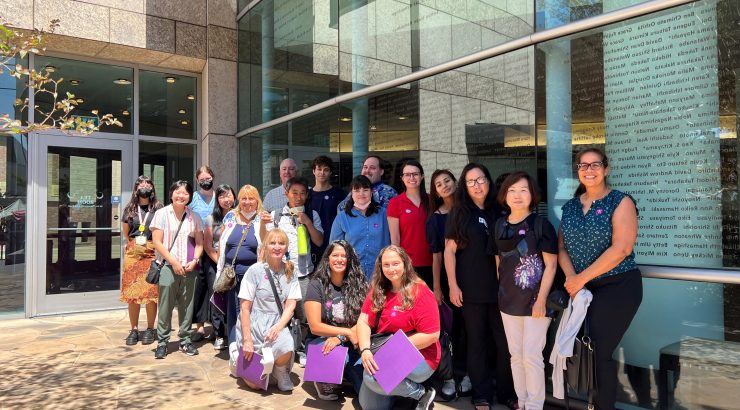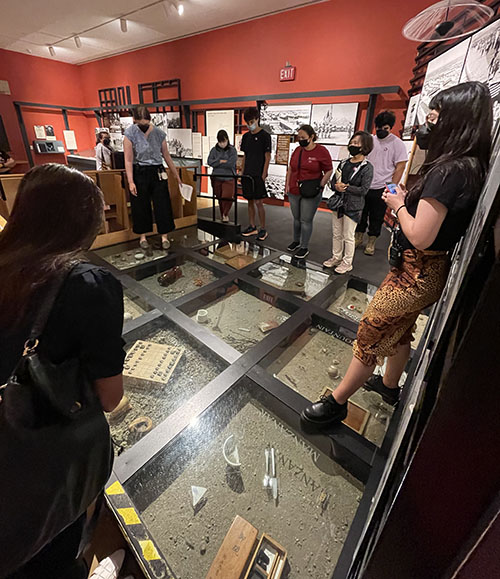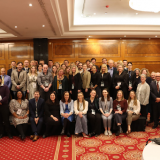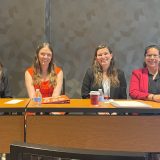
Wilkinson Students Explore the Japanese American National Museum
September 16, 2022
 My high school glossed over the incarceration of 100,000 Japanese immigrants and Japanese Americans in World War II, rendering a historical blind spot in my education. I don’t think this was by accident—the American school system often romanticizes the United States’ role in World II. With hotly contested debates over critical race theory being taught in schools, recognizing America’s uncomfortable and ugly past is more pressing than ever. So, when my professor, Dr. Jan Osborn (English) asked if I was interested in going to the Japanese American National Museum (JANM) to attend an educator workshop I jumped at the opportunity to challenge my limited perspective.
My high school glossed over the incarceration of 100,000 Japanese immigrants and Japanese Americans in World War II, rendering a historical blind spot in my education. I don’t think this was by accident—the American school system often romanticizes the United States’ role in World II. With hotly contested debates over critical race theory being taught in schools, recognizing America’s uncomfortable and ugly past is more pressing than ever. So, when my professor, Dr. Jan Osborn (English) asked if I was interested in going to the Japanese American National Museum (JANM) to attend an educator workshop I jumped at the opportunity to challenge my limited perspective.
I attended with a group of undergraduates, graduates, and professors and saw featured exhibitions at JANM. The train ride from Orange to Union Station only took around fifty minutes, and the museum was a brief ten-minute walk from there. Located in Little Tokyo, the museum sits across from the first Buddhist temple building in Los Angeles. Standing outside the museum, Ann Burroughs, JANM President and CEO, explained that this temple was where the Japanese American population stored belongings after being forcibly removed from their homes by the U.S. government.  It was also where many Japanese Americans temporarily stayed after returning from the internment camps. While just being outside of the museum, I was deeply moved by all the history that occurred where I was standing.
It was also where many Japanese Americans temporarily stayed after returning from the internment camps. While just being outside of the museum, I was deeply moved by all the history that occurred where I was standing.
Once inside, we were greeted by a museum curator and an educator who led the workshop. It began by examining a civilian exclusion order, which listed the demands made by the U.S. government to those of Japanese ancestry to “evacuate” their homes. After analyzing the document, many pointed out how the order was issued just two days before the deportation happened, leaving little time for those affected to gather their belongings or say goodbye to loved ones. These gut-wrenching insights are brought to life by the details of documents like the civilian exclusion order. JANM houses over 150,000 artifacts that tell the story of the Japanese American experience. I would implore any Chapman students to take the opportunity to use this resource to perform their own analysis and weave it into the collective tapestry of Japanese American history.
 After the workshop, we got a chance to explore the museum’s many interactive, digital, and physical exhibits. My favorite exhibit was “The Interactive Story File of Lawson Iichiro Sakai,” which collected over 1000 responses from Lawson to questions like “what’s your favorite flavor of ice cream?”, “tell me about the smells of war,” and “what were the internment camps like?” This allows visitors to have a conversation with Lawson and memorializes his legacy. I think this exhibit embodies what’s truly profound about JANM; it captures the Japanese American experience in its entirety—telling both a story of historical atrocities and remarkable resilience that can ultimately inform us on how to create a better world.
After the workshop, we got a chance to explore the museum’s many interactive, digital, and physical exhibits. My favorite exhibit was “The Interactive Story File of Lawson Iichiro Sakai,” which collected over 1000 responses from Lawson to questions like “what’s your favorite flavor of ice cream?”, “tell me about the smells of war,” and “what were the internment camps like?” This allows visitors to have a conversation with Lawson and memorializes his legacy. I think this exhibit embodies what’s truly profound about JANM; it captures the Japanese American experience in its entirety—telling both a story of historical atrocities and remarkable resilience that can ultimately inform us on how to create a better world.
The field trip to the Japanese American National Museum was made possible by the generous support of a National Endowment for the Humanities grant.

